Ryogoku
Ryogoku is a small area on the banks of the Sumida River, in the east of the city, full of places of tourist interest. Since 1909, when the first sumo arena was built, it has been considered the reference district of Tokyo and all of Japan for the sumo world. In addition to the Kokugikan arena, which hosts the most important national tournaments, Ryogoku has numerous gyms and other attractions related to the world of sumo. In the district there are also several important museums and a park that symbolizes the memory of all the disasters of the twentieth century that hit the city.
Things to do and things to see in Ryogoku
The sumo district
Although full of museums and other places of interest (read the rest of this page), Ryogoku is famous throughout Japan and all Tokyo travel guides as the
world center of sumo. The city's sumo tournaments have been held in Ryogoku's
Kokugikan arena since 1909, while before that they used to take place outdoors in temples and shrines. In the neighborhood there are also many gyms for sumo wrestlers (
sumo beya), a small museum, and numerous
chanko restaurants, the dish at the base of the particular high-protein and high-calorie diet of those who practice this sport.
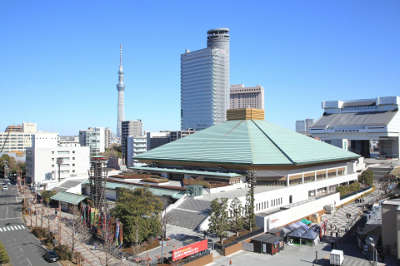
Kokugikan
The Kokugikan (両国国技館) is the most important sumo arena in the world, located next to the Edo-Tokyo Museum in Ryogoku. The growing popularity of Sumo during the Meiji period led to the construction of the original Kokugikan in 1909, but the current building was inaugurated in 1985 and has 11,098 seats. It is mainly used for sumo tournaments (honbasho) and houses a small sumo museum open all year round. The facility is also used to host concerts and other combat sports events (boxing and wrestling).
Sumo tournaments
Sumo tournaments take place in January (hatsu honbasho), May (natsu honbasho) and September (aki honbasho), and every tournament lasts about 15 days. These tournaments are quite "friendly" for foreigners, in fact there are brochures with the various programs in English, and also it is possible to rent radios that comment on the matches in English. Ticket prices vary according to the type of seat and the distance of the seat from the ring, between 3500¥ and 8000¥. Tickets can be purchased at the ticket office of the arena, at konbini stores, or more easily on the internet. More information on this website.
Even if you are not planning to attend the tournament matches, it is recommended that you visit the Ryogoku district if there is a sumo tournament going on during your days in Tokyo. The neighborhood is very active and near the area you can come across interesting events such as the arrival of famous wrestlers surrounded by photographers, fans and so on.
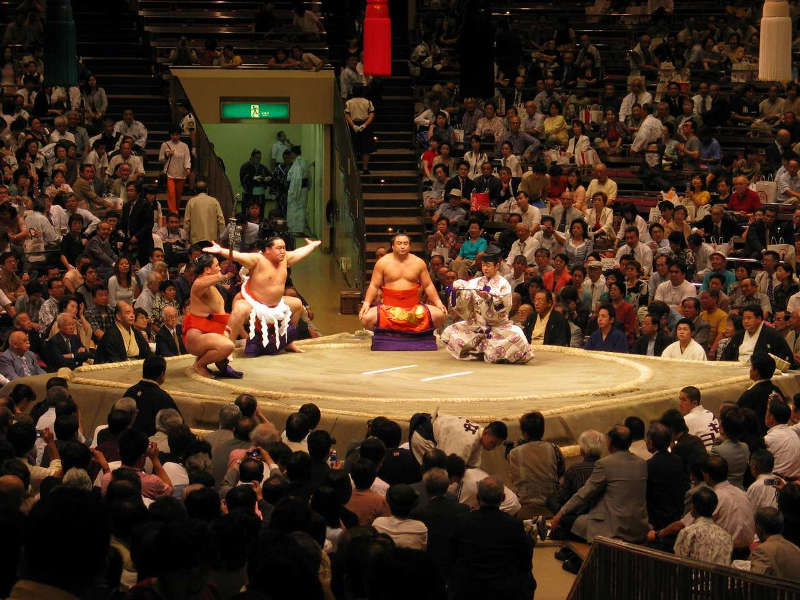 the ceremony before a match inside the Kokugikan
the ceremony before a match inside the Kokugikan
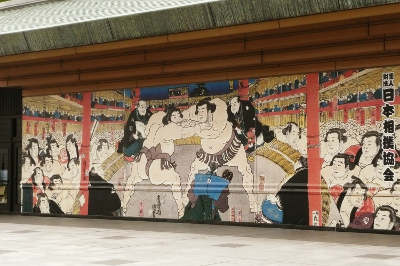
Sumo Museum
(free admission, opening hours 10:00-16:30, closed on weekends)
A very small museum, inside the Kokugikan arena. Not particularly recommended, unless you have a deep passion and knowledge of this sport. When there is a sumo tournament in progress, only ticket holders can enter.
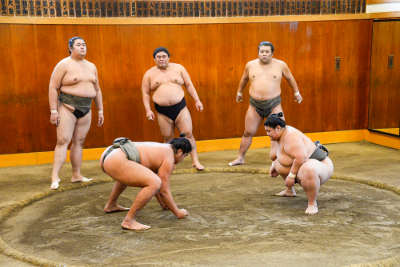
Sumo gyms (sumo beya)
Ryogoku is also the neighborhood of sumo beya (相撲部屋), or the gyms where sumo wrestlers train. There are at least thirty of them around Ryogoku and in some cases it is possible to attend the traditional morning training session of the wrestlers, known as asageiko. Workouts typically begin between 6 and 7 in the morning and last at least three hours. Some gyms are much more "open" and friendly than others in accepting outside observers, especially foreign tourists. In any case it is important to being able to speak a bit of Japanese or to have a Japanese friend who can help you. It is in fact a good idea to call the day before, first of all to inquire if there will be a training session the next morning, and also to ask for permission to observe. Among the most popular sumo beya among tourists, we suggest the Asakayama beya and the Musashigawa Beya.
Alternatively, there are several private tours that include the visit of a sumo beya, but obviously they have a significant cost, or you can go to the Arashio beya.
Arashio beya
The Arashio beya is a major sumo wrestling gym established in 2002. It is located about 20 minutes walk from the Kokugikan arena, across the Sumida River. Over the years it has become very popular with tourists because it is possible to attend the morning workouts very easily, without the need for reservations or anything else, simply by going there and looking from outside through the windows. The gym's sumo wrestlers also usually go outside to take photos with the tourists at the end of their workouts. However, keep in mind the fact that you will have to stand on a busy street, and that if there are a lot of people it could be difficult to be able to observe well what happens behind the windows.
Yokoami-chō Park
Historical background of Yokoami-chō Park
In the area now occupied by the Yokoami-chō Park, construction work on a park had already begun in 1922. However, on 1 September 1923 the city was hit by the devastating Great Kantō earthquake, following which many people were evacuated to this area. Unfortunately, a great fire broke out right here, which gave rise to a firestorm in which many evacuees from the earthquake lost their lives. In September 1930, the Yokoami-chō Park was finally inaugurated. To remember the people who lost their lives in the earthquake, the
Tokyo Metropolitan Memorial Hall and the
Great Kanto Earthquake Memorial Museum were built inside the park.
Furthermore, during the great earthquake of 1923, word spread that some Korean immigrants were taking advantage of the situation to carry out looting and arson, thus a wave of violence was unleashed which led to the killing of many Korean immigrants, it is estimated around six thousand kills. For this reason, inside this park there is also a
stone monument to commemorate the Koreans murdered following the earthquake.
Twenty years later, another catastrophic event struck the city of Tokyo, namely the bombings of the Second World War, and in particular the attack of March 10, 1945. That night, 279 American bombers carried out what is considered by all to be the single most destructive air strike in the history of mankind, killing more than ninety thousand people, mostly civilians. After the war, bodies that had been buried in mass graves were exhumed and cremated, and the ashes buried in an ossuary located in Yokoami-chō Park, which has since become a memorial site for not only all the lives lost during the earthquake but also for the fallen during the bombing of the war. In 2001, a
monument was erected to commemorate the victims of the Tokyo air raids.
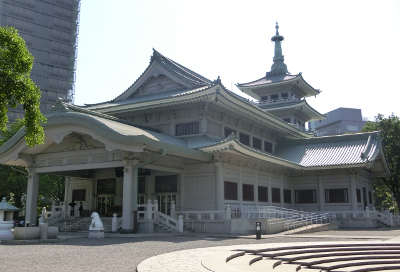
Tokyo Metropolitan Memorial Hall
This impressive memorial hall (Tokyo Ireido) was built in 1930 to house the remains of some 58,000 victims of the Great Kantō earthquake. Later, some remains of the victims of the great Tokyo air raid of 10 March 1945 were also kept here. Now in this room about 163,000 remains of both victims of the earthquake and the disaster of the war are kept.
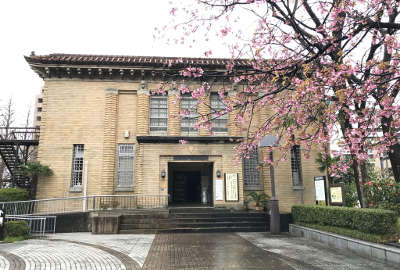
Great Kanto Earthquake Memorial Museum
(free admission, opening hours 9-17, closed on mondays)
This small museum was opened in 1931 to convey the memory of the earthquake disaster to future generations and to commemorate Tokyo's important rebuilding feat. Subsequently, the testimonies of the disaster of the great Tokyo air raid were added, to remind everyone that the peace and prosperity in which the city lives today was only achieved after countless sacrifices. Inside there are artifacts from the earthquake and the war disaster, images, photographs, and other material. Visiting the museum and Yokoami-chō Park doesn't take long, but it will give you a lot to think about.
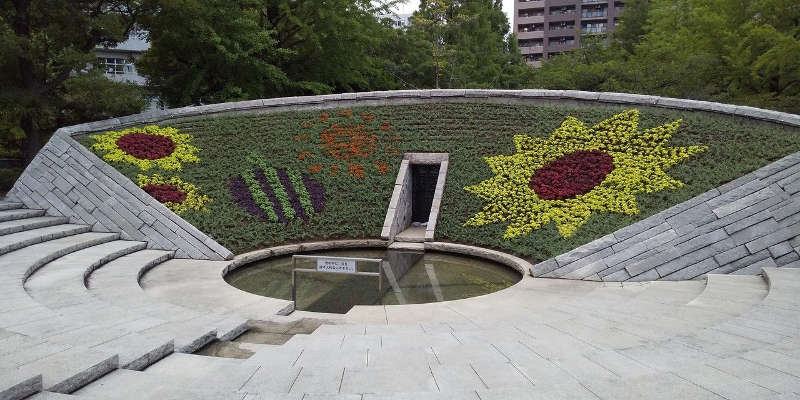 the monument dedicated to the victims of the air raids and to world peace inside the Yokoami-chō Park
the monument dedicated to the victims of the air raids and to world peace inside the Yokoami-chō Park
Other places of interest
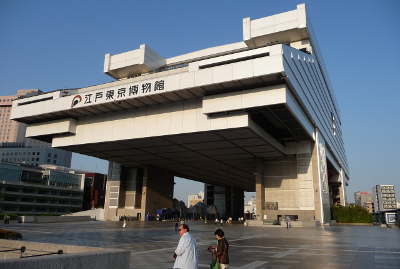
Edo Tokyo Museum
(admission 600¥, opening hours 9:30-17:30, until 19:30 on saturday, closed on monday)
The Edo-Tokyo Museum is located next to the Kokugikan arena, in a huge, unique-looking building designed by Kiyonori Kikutake, one of the founders of metabolist architecture. There are eight floors in all, one underground and seven raised from the ground by four 20-meter high columns, with an open-air plaza just below them. The museum traces the entire history of Tokyo (Edo was its ancient name), from its foundation in the Edo period (1603-1868) to the present day. It is one of the most popular museums among tourists, also recommended for those who do not particularly like "educational" attractions. Here you can learn many interesting things about the history of the city, also thanks to beautiful scale and non-scale reconstructions of buildings and neighborhoods over time. At the entrance to the museum stands a life-size reconstruction of the ancient access road to the city, the Nihonbashi Bridge.
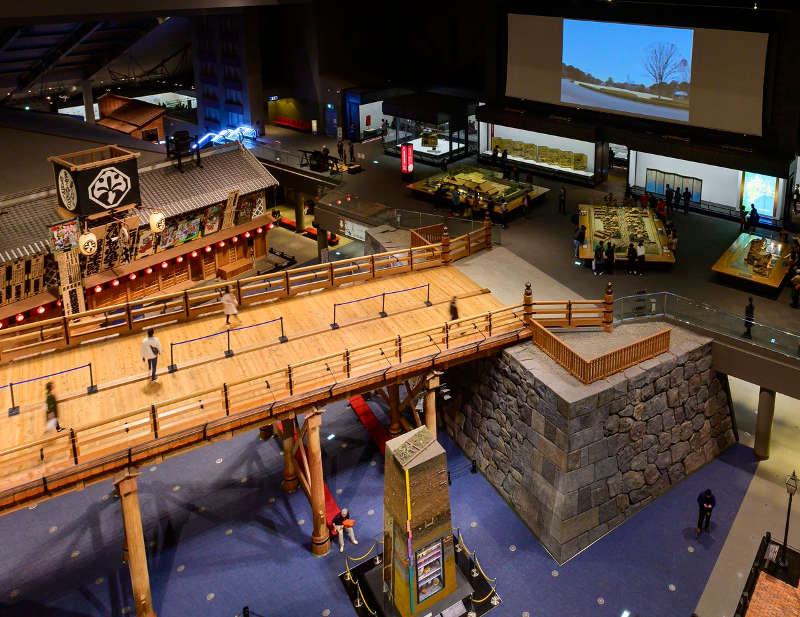 the interior of the museum and the reconstruction of the Nihonbashi Bridge
the interior of the museum and the reconstruction of the Nihonbashi Bridge
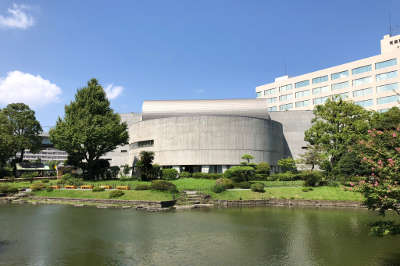
Japanese Sword Museum
(admission 1000¥, opening hours 9:30-17:00, closed on mondays)
This museum, Tōken hakubutsukan (刀剣博物館) in japanese, is a small museum dedicated to the art of the Japanese sword. Inside you will find a large collection of swords (mainly katana) of high historical or artistic value, and other related objects. Previously located in Shinjuku, the museum is now housed in this modern three-story building, which opened in 2018 next to the Kyu-Yasuda Teien garden. On the top floor there is also a terrace overlooking the gardens. A visit to this museum is highly recommended only if you are very fond of swords.
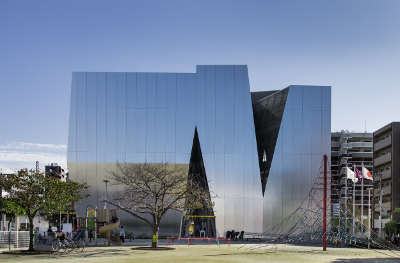
The Sumida Hokusai Museum
(admission 400¥, opening hours 9:30-17:30, closed on mondays)
The Sumida Hokusai Museum (すみだ北斎美術館) is a museum dedicated to the artist Katsushika Hokusai (1760-1849), commonly known throughout the world simply as Hokusai. He is the most famous Japanese painter of all time, best known for his ukiyo-e works, which have inspired many European Impressionists such as Claude Monet and post-impressionists such as Vincent van Gogh, and that since the mid-nineteenth century have contributed to spreading that mysterious charm of places and faces of Japan throughout the West.
The museum opened in 2016 in the neighborhood where Hokusai spent most of his life. The museum building is a remarkable architectural attraction in itself, designed by Sejima Kazuyo, co-founder of the SANAA architecture firm. Inside you will find numerous information on the life of the painter, as well as numerous high quality reproductions of all the most famous works of Hokusai. You got it right, this museum unfortunately does not have works by the master Hokusai in its permanent collection, because they are largely scattered around museums around the world. However, a separate section of the museum (with variable admission fees, averaging around 1000¥) hosts special exhibits including original works on loan, both by Hokusai and other authors. You can check out the current exhibitions at this page.
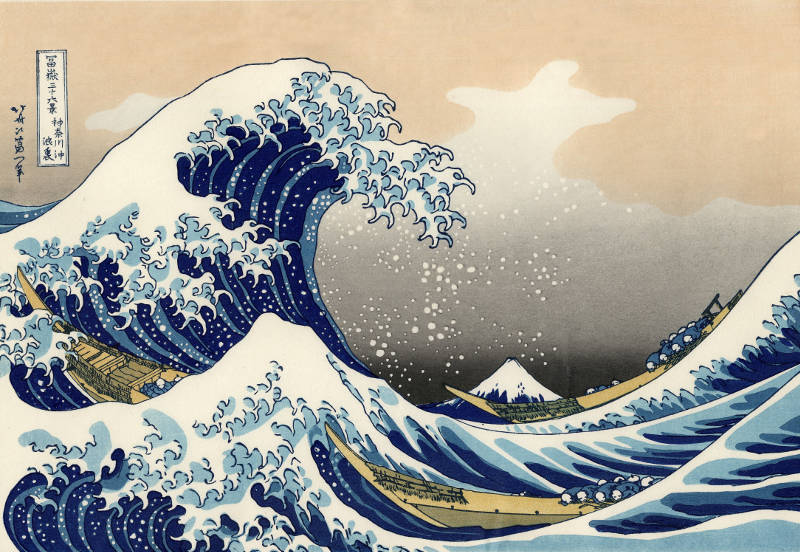 "The Great Wave off Kanagawa", perhaps the most famous Hokusai work in the world
"The Great Wave off Kanagawa", perhaps the most famous Hokusai work in the world
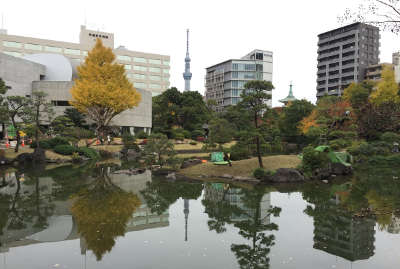
Kyu-Yasuda Teien
(free admission, opening hours 9:00-16:30)
This garden (literally "Former Yasuda Garden") is a small and unknown oasis of peace next to the Kokugikan arena and in front of the Japanese Sword Museum. The garden was built by a feudal lord of the time between 1688 and 1703, with a mechanism that took water from the nearby Sumida River. However, today it no longer has any historical value, as it was rebuilt in 1971 and the internal lake no longer takes water from the river, but the tide is artificially simulated by a pump. The original garden was destroyed by the increasing pollution of the river, the last earthquake and finally the war. The fact remains that if you are already in the area it is worth taking a stroll. From one corner of the garden you can also see the Tokyo Skytree.
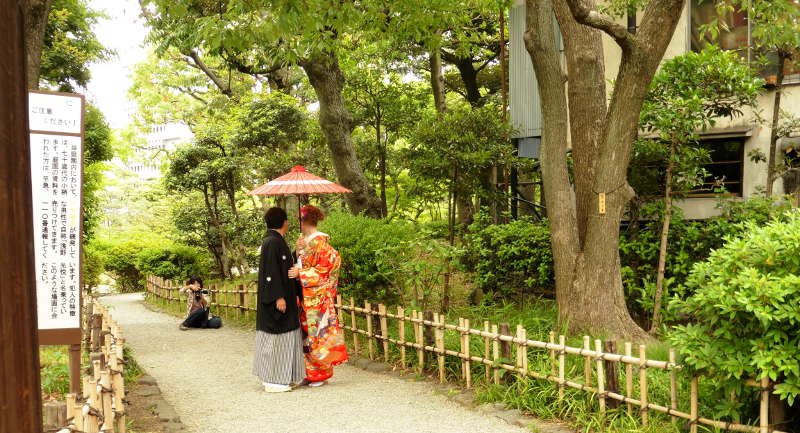 Kyu-Yasuda Teien Garden is often visited by newlywed couples to take pictures in traditional dress
Kyu-Yasuda Teien Garden is often visited by newlywed couples to take pictures in traditional dress
Where to stay in Ryogoku, recommended hotels
Pros and cons
Ryogoku is not a central district of Tokyo, however it is well connected by rail and subway and it is easy to reach most of the more central districts. There are several hotels and hostels at very low prices compared to the average in the city, making it a great neighborhood for those looking for low cost accommodation. There are many tourist attractions and also many restaurants. However, it is an aesthetically very ugly neighborhood, it is a residential-industrial area, with an elevated highway that basically prevents access to the riverfront, and that does not arouse any particular emotion as a whole. The neighborhood only comes to life when there are sumo tournaments.
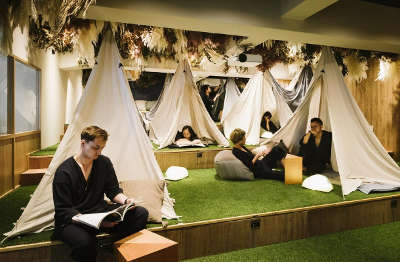 The dream hostel of any backpacker traveling alone. Here you can sleep inside a tent, in a large artificial internal garden shared with the other guests of the hostel, each in their own tent. Each tent can accommodate a maximum of three people. Furthermore, inside there is a beautiful cinema room, where a film is shown every evening, to be watched in the company of the other guests, and a café-bar where you can have breakfast in the morning or have a drink in the evening.
Price range: tent for one person 2,000-3,000¥, for two people 2,500-4,000¥.
The dream hostel of any backpacker traveling alone. Here you can sleep inside a tent, in a large artificial internal garden shared with the other guests of the hostel, each in their own tent. Each tent can accommodate a maximum of three people. Furthermore, inside there is a beautiful cinema room, where a film is shown every evening, to be watched in the company of the other guests, and a café-bar where you can have breakfast in the morning or have a drink in the evening.
Price range: tent for one person 2,000-3,000¥, for two people 2,500-4,000¥.
Recommended hotels
Eating and drinking in Ryogoku
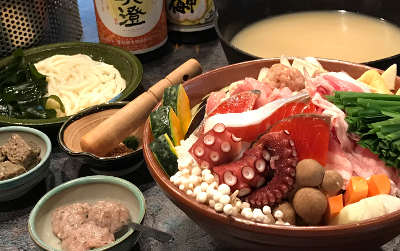
Chankonabe restaurants
Chanko (also called
chankonabe, ちゃんこ鍋) is a stew made from chicken broth, in which various ingredients are cooked. The dish does not have a fixed recipe but can vary depending on what is available. A good chankonabe should include large amounts of protein sources (chicken, fish, tofu, rarely beef) and mixed vegetables. The remaining broth at the end can also be eaten with noodles. This protein-rich dish, served in large quantities, is the basis of the
sumo wrestlers' diet for weight gain, and the Ryogoku neighborhood is full of restaurants serving this specialty. If you also want to try the typical diet of a sumo wrestler, we particularly recommend:
- Kappo Yoshiba, considered by some to be the best chanko restaurant in the area, although the menu also includes other dishes such as sushi. It is located inside a former sumo gym, in the center of the restaurant you can still see the ring.
- Chanko Kawasaki, a small restaurant serving the most traditional recipes of this dish. It is said to be the oldest restaurant in the neighborhood, and opened in 1937.
- Hananomai, a traditionally-decorated izakaya serving a variety of dishes, including chanko.
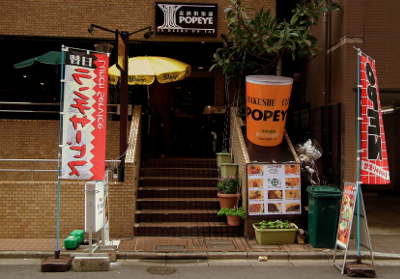
Popeye Beer Club
The Popeye Beer Club in Ryogoku is a pub with over 70 draft beers, most of which are Japanese craft beers, but there is also a choice of imported beer, and you can also order different types of food. A 1780¥ menu offers you the opportunity to try up to 10 types of beers.
How to get to Ryogoku
The neighborhood is well served by the
JR Ryogoku train station (
Chūō–Sōbu line), just four minutes by train from Akihabara and 20 minutes from Shinjuku. The main exit is the
West Exit, located a few meters from the Kokugikan arena.
A few hundred meters to the west of the railway station there is also a subway station, also called
Ryogoku and served by the
Toei Oedo line. Exits A3 and A4 of this station are located right in front of the Edo Tokyo Museum.
Map of Ryogoku, Tokyo
Guided tours, activities and other things to do
If you are planning a trip to Japan and you want to do something more than just visiting famous places and monuments, we suggest you to use
Rakuten Travel Experiences.
How to use Rakuten Travel Experiences
Rakuten Travel is a very useful website to
enrich your travel experience, especially if you are going solo or it's your first time in Japan.
Because of the language barrier (and more), in Japan it is very difficult to interact with the locals and to get off the tourist track.
Thanks to Rakuten Travel you can find a lot of interesting and sometimes unique
guided tours and activities all over Japan (and not only in Japan), that you would otherwise never be able to enjoy.
But there's more: on Rakuten Travel you can also
buy tickets for several famous attractions, events, transportation and other useful services for tourists. Last but not least, you can
reserve a table in hundreds of restaurants.
Some examples
Take a look at Rakuten Travel Experiences
You may also be interested in





 the monument dedicated to the victims of the air raids and to world peace inside the Yokoami-chō Park
the monument dedicated to the victims of the air raids and to world peace inside the Yokoami-chō Park




 The dream hostel of any backpacker traveling alone. Here you can sleep inside a tent, in a large artificial internal garden shared with the other guests of the hostel, each in their own tent. Each tent can accommodate a maximum of three people. Furthermore, inside there is a beautiful cinema room, where a film is shown every evening, to be watched in the company of the other guests, and a café-bar where you can have breakfast in the morning or have a drink in the evening.
Price range: tent for one person 2,000-3,000¥, for two people 2,500-4,000¥.
The dream hostel of any backpacker traveling alone. Here you can sleep inside a tent, in a large artificial internal garden shared with the other guests of the hostel, each in their own tent. Each tent can accommodate a maximum of three people. Furthermore, inside there is a beautiful cinema room, where a film is shown every evening, to be watched in the company of the other guests, and a café-bar where you can have breakfast in the morning or have a drink in the evening.
Price range: tent for one person 2,000-3,000¥, for two people 2,500-4,000¥.

